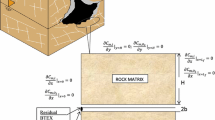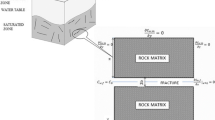Abstract
Monitoring of BTX natural attenuation in a fractured rock aquifer is highly challenging due to lack of knowledge about the influence of interaction of heterogeneous domains on transport processes. Contaminant transport in a fractured rock is commonly investigated using dual continuum models by considering fracture and its surrounding rock–matrix as two different continuums. In this study, a numerical multi-component transport model based on a triple continuum modeling approach is developed to investigate the transport of dissolved BTX in a discretely fractured aquifer with fracture–skin. A residual BTX source zone is considered to be present at the fracture inlet. A multi-component dissolution model is coupled with the present numerical model to simulate the dissolution of benzene, toluene and xylene at the residual BTX source. Dissolved BTX components are considered to undergo sorption and biodegradation in addition to advection and dispersion within the fracture. Dissolved BTX components diffusing to fracture–skin and rock–matrix are considered to undergo sorption and biodegradation in fracture–skin and rock–matrix. A novel sensitivity analysis approach based on spatial moments is introduced in the manuscript to investigate the sensitivity of various flow and transport parameters of fracture–skin and rock–matrix on dissolved BTX mass retained in fracture and matrix. The presence of fracture–skin is found to significantly affect the concentration distribution and mass retention of dissolved BTX components in a fractured aquifer.








Similar content being viewed by others
References
Barenblatt GI, Zheltov IP, Kochina IN (1960) Basics concepts in the theory of seepage of homogeneous liquids in fissured rocks. J Appl Math Mech 24:1286–1303
Chopra M, Sunny F, Oza RB (2016) Numerical modeling of colloid-facilitated radionuclide decaychain transport in a coupled fracture-matrix system. Environ Earth Sci 75:1300–1312
Driese SG, McKay LD, Penfield CP (2001) Lithologic and pedogenic influences on porosity distribution and groundwater flow in fractured sedimentary saprolite: a new application of environmental sedimentology. J Sediment Res 71:843–857
Fu L, Milliken KL, Sharp JM Jr (1994) Porosity and permeability variations in the fractured and liesegang-banded Breathitt sandstone (Middle Pennsylvanian), eastern Kentucky: diagenetic controls and implications for modelling dual porosity systems. J Hydrol 154:351–381
Garner TT, Sharp JM (2004) Hydraulic properties of granitic fracture skins and their effects on solute transport. In: Proceedings of the 2004 U.S EPA/NGWA, fractured rock conference: state of the science and measuring success in remediation, national Groundwater Association, Dublin, Ohio, pp 664–678
Grisak GE, Pickens JF (1980a) Solute transport through fractured media. I: the effect of matrix diffusion. Water Resour Res 16:719–730
Grisak GE, Pickens JF (1980b) Solute transport through fractured media. II: column study of fractured till. Water Resour Res 16:731–739
Hansen SK, Kueper BH (2014) A new model for coupled multicomponent NAPL dissolution and aqueous-phase transport, with application to creosote dissolution in discrete fractures. Water Resour Res 50:58–70
König LF, Weiss JL (1990) Groundwater: modelling, management and contamination. https://www.scribd.com/document/51512162/GroundwaterModelling
Kreisel I, Sharp JM Jr (1996) Fracture skins in the Brushy Canyon Formation. The Brushy Canyon play in outcrop and subsurface: concepts and examples. Dissertation, The University of Texas
Kumar GS, Sekhar M (2005) Spatial moment analysis for transport of nonreactive solutes in fracture-matrix system. J Hydrol Eng 10:192–199
Maloszewski P, Zuber A (1985) On the theory of tracer experiments in fissured rocks with a porous matrix. J Hydrol 79:333–358
Moench AF (1984) Double-porosity models for a fissured groundwater reservoir with fracture skin. Water Resour Res 20:831–846
Moench AF (1995) Convergent radial dispersion in a double-porosity aquifer with fracture skin: analytical solution and application to a field experiment in fractured chalk. Water Resour Res 31:1823–1835
Molson JW, Frind EO, van Stempvoort DR, Lesage S (2002) Humic acid-enhanced remediation of an emplaced diesel source in groundwater 2: numerical model development and application. J Contam Hydrol 54:277–305
Nair VV, Thampi SG (2010) Numerical modeling of colloid transport in sets of parallel fractures with fracture skin. Colloids Surf A 364:109–115
Natarajan N, Suresh Kumar G (2012) Effect of fracture-skin on virus transport in fractured porous media. Geosci Front 3(6):893–900
Natarajan N, Suresh Kumar G (2016) Spatial moment analysis of solute transport with Langmuir sorption in a fracture-skin-matrix coupled system. J King Saud Univ Eng Sci 28:157–164
Neretnieks I, Eriksen T, Tahtinen P (1982) Tracer movement in a single fissure in granitic rock: some experimental results and their interpretation. Water Resour Res 184:849–858
Pasandi MN, Samani N, Barry DA (2008) Effect of wellbore storage and finite thickness skin on flow to a partially penetrating well in a phreatic aquifer. Adv Water Resour 31(2):383–398
Polak A, Grader AS, Wallach R, Nativ R (2003) Chemical diffusion between a fracture and the surrounding matrix, measurement by computed tomography and modeling. Water Resour Res 39:1106–1116
Renu V, Suresh Kumar G (2012) Numerical modeling and spatial moment analysis of solute mobility and spreading in a coupled fracture-skin-matrix system. Geotech Geol Eng 30:1289–1302
Renu V, Suresh Kumar G (2014) Temporal moment analysis of solute transport in a coupled fracture-skin-matrix system. Sadhana Indian Acad Sci 39:487–509
Renu V, Suresh Kumar G (2016) Temporal Moment analysis of multi-species radionuclide transport in a coupled fracture-skin-matrix system with a variable fracture aperture. Environ Model Assess 21:547–562
Robinson NI, Sharp JM Jr, Kriesel Ilan (1998) Contaminant transport in a set of parallel fractures with fracture skin. J Contam Hydrol 31:83–109
Sharp JM (1993) Fractured aquifers/reservoirs; approaches, problems, and opportunities. In: Banks D, Banks S (eds) Hydrogeology of hard rocks, memoires of the 24th congress international association hydrogeologists. Oslo, Norway, vol 24, pp 23–38
Sudicky EA, Frind EO (1982) Contaminant transport in fractured porous media: analytical solutions for a system of parallel fractures. Water Resour Res 18:1634–1642
Tang DH, Frind EO, Sudicky EA (1981) Contaminant transport in fractured porous media: analytical solution for a single fracture. Water Resour Res 17:555–564
Warren JE, Root PJ (1963) The behavior of naturally fractured reservoirs. Soc Pet Eng J 13(3):345–355
Author information
Authors and Affiliations
Corresponding author
Electronic supplementary material
Below is the link to the electronic supplementary material.
Rights and permissions
About this article
Cite this article
Valsala, R., Suresh Kumar, G. Multi-component transport of BTX in a discretely fractured aquifer with fracture–skin: numerical investigation and sensitivity analysis. Environ Earth Sci 76, 619 (2017). https://doi.org/10.1007/s12665-017-6956-3
Received:
Accepted:
Published:
DOI: https://doi.org/10.1007/s12665-017-6956-3




